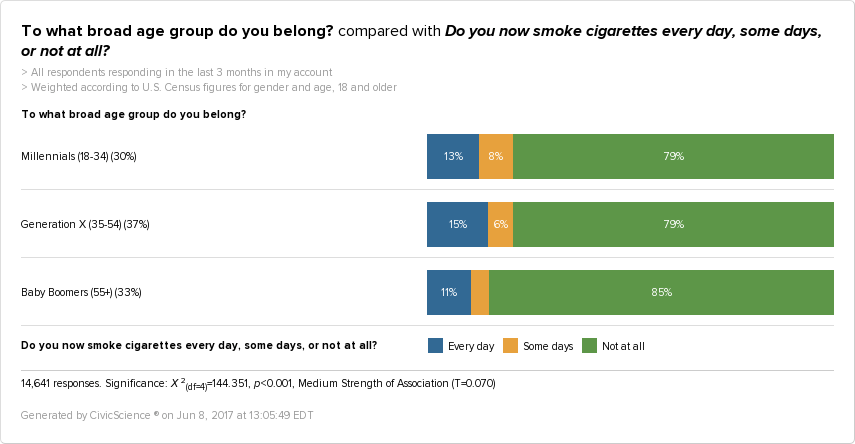I’d love to have a cigarette right now. There, I said it.
I’d also love to eat Eggs Benedict every morning, drink a Unicorn Frappucino, drive without a seatbelt, and lay out in the sun until I’m golden brown. But I can’t. I kind of want to be there when my daughters get married and my grandchildren are born. The Surgeon General is such a buzz kill.
Not that I’m immune to the occasional, alcohol-induced Parliament. “Everything in moderation, when you’re drinking in excess,” said Buddha – or somebody. But I always wake up the next morning regretting it and that’s what keeps me on the almost-straight-and-narrow. It’s also not nearly as fun to smoke anymore, since nobody else does it. At least in my normal circles, smoking is pretty much dead.
SMOKING > NEW TECH
However, while the rate of cigarette smoking has plummeted in the U.S., CivicScience data tell us that a full 13% of American adults still smoke ‘every day,’ while another 6% (yours truly, sheepishly included) smoke ‘some days.’ See for yourself:

13% may not seem like many people. But consider this: It’s more than the percentage of people who own a VR headset (10%), wear a smart watch (8%), use a smart speaker like Amazon’s Alexa (11%), or watch Hulu on a regular basis (12%). And, given the skyrocketing cost of cigarettes, consumer spending in the category trumps those other trendy industries. Cigarette companies reported record profits this year.
The economic impact of smoking doesn’t stop there. When we query our database about a given population of people (in this case, daily smokers), an algorithm ranks the tens-of-thousands of other questions we’ve asked, based on how strongly they correlate with that attribute. This one (below) ranked a clear #1, even above “How often do you exercise?” (#2):

Nearly 1/3 of people who buy food or drinks at convenience stores on a regular basis smoke every day. Picture them walking in to buy a pack of smokes, grabbing a Coke out of the cooler, and ordering a breakfast sandwich at a kiosk, while filling their car with gas. Not only are these smokers bolstering revenues at fast-growing “food-forward C-stores” like Wawa or Sheetz; they’re driving increased sales for a litany of CPG brands, soft drink manufacturers, and every other product category that adorns their shelves. Nobody wants them to quit.
THE SMOKER PROFILE
As the cigarette manufacturers, retailers, and other brands rake in the money from these trend-defiant smokers, let’s take a quick look at who they are.
First, perhaps surprisingly, daily smokers are more likely to be women. Occasional smokers are more likely to be men. Age wasn’t the big factor I expected. Millennials are the most likely to smoke “some days,” while Gen Xers make up the largest group of daily smokers. More Millennials smoke every day (13%) than Baby Boomers (11%).

People in the U.S. Midwest are the most likely to smoke every day. People in the Northeast are the least likely to smoke at all. Daily smokers are slightly more likely to live in rural areas, have less than a college degree, and make under $50,000 in household income – troubling when considering the fact that the average cost of a pack of cigarettes is now $6.42.
A lot of the other correlations make sense. Daily smokers are much less likely than average to exercise regularly or read the nutritional content on the food they buy. They eat fast food more often, watch more television (particularly sitcoms), and are more likely to rent their homes (see: Millennials). They’re less likely to eat breakfast, more likely to do their own car repairs, and over-index as fans of Samuel L. Jackson, Gary Busey, and Adam Sandler.
GET USED TO IT
While smoking has become taboo, if not offensive, to many people, smokers still make up a large and commercially powerful group of consumers. And, with Millennials still smoking at a formidable rate, we may not see the habit disappearing anytime soon. Marketers, take note.








